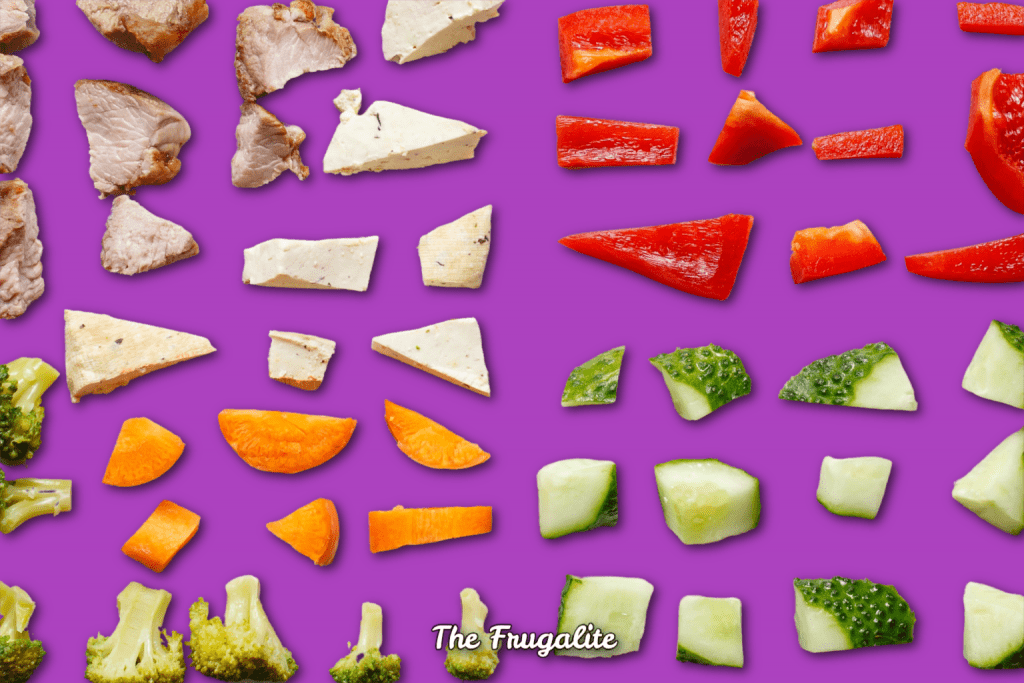(Psst: The FTC wants me to remind you that this website contains affiliate links. That means if you make a purchase from a link you click on, I might receive a small commission. This does not increase the price you’ll pay for that item nor does it decrease the awesomeness of the item. ~ Daisy)
How long does it take you to use a pound of butter or a container of margarine? How long does that two-pound pack of your favorite coffee last you? How long does one standard roll of toilet paper last your household? In this article, I am going to describe how tracking your use of food and household staples is the first step in what I call “flexible rationing.” Once you are aware of your use, you can adapt your use immediately to suit your budget on any given week or month.
Tracking usage of key items
The first step in flexible rationing is to track your usage of key items. In most cases, these would be the most expensive items on your grocery and household list. These days, meat comes to mind. In my household, butter is another, as are coffee beans, one of my favorites. Because I produce all of my own dairy products (kefir and cheese) from organic whole milk, this is another key purchase weekly and monthly. Other items that you might be interested in tracking may not be the most expensive but might be frequently used: toilet paper and soaps would be other examples of these.
The budget balancing act
With inflation hitting record levels, we are all facing challenges balancing our budgets. I eat mainly whole foods and produce a lot of my own foods at home, such as bread, muffins, and the dairy products I mentioned. When I shop, it is often just for a few whole food items, such as the nuts and seeds I eat that I can’t grow. However, when I walk the aisles, I cannot help but exclaim out loud in shock at the prices. Truly, in our region, many grocery items have increased at least 50% in price over the past year or so. So, for most of us, balancing our budget is not easy. The method I describe here is how I manage to keep afloat during difficult times.
When to ration
I tend to think of my budget in weekly and monthly chunks. My monthly income and my basic bills don’t vary much from month to month. Therefore, I have a pretty good sense of how much margin I have in a given month. These days, it isn’t a lot! There are some months with extra expenses: Last month, I saw one expected seasonal expense (changing over tires) and one expected extra expense (dentist), and an unexpected expense (urgently needed herbal medicine). All of that added up to around $200. Without a lot of space in my budget, I had to look at my grocery and household purchases for savings.
What to ration
Realizing money would be tight for the month, I immediately went on high alert. What was immediately cut: eating out. No eating out. Nothing. Okay. I can do this! What was immediately rationed: all driving trips. No driving for fun. Don’t leave the driveway unless you have at least three errands to do. Do not do it. Okay. I can do this!
Realistically, I could see that I would need to be drawing on my pantry to get through the rest of this month. If you are looking for tips on how to build a pantry on a budget, here is a great article. For my situation, I realized I needed to draw on my pantry AND ration what I had. I looked at some of the more expensive items that I rely on and developed a plan.
Meat: Cancelled. No buying meat until this month’s end, and then I will reassess. I need protein with my high activity levels, so I had to be creative. I bought four cans of six-bean medley on sale for less than a dollar each.
Bean salad, anyone? One can of bean medley mixed with basic pantry items and early season garden greens, raw asparagus, and onions make me a healthy salad that gives me four supper meals. You can’t beat that price for a healthy meal! If I truly get a meat craving, I bought a pack of bacon on sale a while ago and parcelled it up into five-piece segments, and froze it. That might be nice for brunch one morning as a treat.
Coffee: A two-pound bag of coffee beans consistently lasts me one month. My cost for this is just under $12. Because I have one more of these bags in my pantry, I decided to keep my one cup of coffee every morning. However, I sometimes have an extra cup some days and decided to cancel that. One cup a day for now. That will ensure that the two-pound bag will last long enough.
If times were even more difficult, I would reduce the size of my cup somewhat. Right now, I grind up four scoops of beans for each cup. Rather than give up my cup a day, I would be more likely to reduce its size to three scoops. That simple choice would allow my two-pound bag to last an extra ten days (40 days!). When money is tight, these things help!
Organic Raisins: I always try to eat organic raisins because grapes are pretty high on the “Dirty Dozen” list of pesticide-contaminated foods (number six). However, I am basically out of organic raisins and none in the pantry. I know that each two-pound bag lasts me about one month, at a cost of about 6 dollars. This is not in the budget right now. My solution: I have a no-name brand bag of non-organic raisins in my emergency pantry. This will do for now. Cost: zero.
Peanut Butter: I eat this every morning on my homemade bread for breakfast. Right now, I add a little honey on top that I bartered for with a friend. I know things need to last a bit longer. I usually put a generous amount on the bread: around 2 Tablespoons. I have several jars in my pantry, but I want these to last. I’m cutting back a bit on my peanut butter each morning to make each jar last a bit longer.
Organic Milk: The main purpose I buy this milk for is to feed my colony of live kefir grains. Their milk requirement is pretty consistent: they need a quart of milk every 24 to 48 hours, or they can be stressed or starve. There isn’t too much I can do about this expense. I eat kefir daily and love it. I use it to make my bread and to make cheese, so this really helps keep my food costs low.
I spend about $7.75 for a gallon of organic milk. The grains go through about a gallon a week. Because the house is warm in the summer, I keep them cool in water on the concrete floor and sometimes add an ice pack. This prevents them from processing the milk any faster.
How to get family on board in difficult times
I’ve shared some ideas for how to track your usage of key items so that you can strategically and consciously cut back in difficult times, whether that be a week or a month, or longer. However, I realize that getting your spouse or family on board could be a challenge. Could it be time to have a difficult conversation with your children?
If you have a finicky eater, you can get advice here on how to not let that break your budget. Taking a positive approach with your family, like focusing on how resiliency can come from difficulties in life, can also help, as well as bringing the kids on board in a family budget planning session.
Stretch that food dollar with strategic rationing.
Strategic tracking of food usage can help us with strategic rationing in times of need. Could you see yourself trying any of the food tracking and rationing tips offered here? Do you have one you can share with us? Please tell us in the comments below.
About Colette
Colette is passionate about sharing her knowledge of thrifty living and self-sufficiency. She has developed her skills in self-reliance living in the suburbs, the city, and more recently, on her own Half-Acre Homestead. Colette lived five years completely off-grid and without running water in an eight by 24 foot tiny home while designing and building her own 18 by 24-foot eco-cabin. She has just launched her website, Half Acre Homestead. Colette invites you to stop by and visit this work in progress! Coming soon in 2022 is her exciting new online program. Interested in Resiliency, Preventative Health, and Self-Sufficient/Off-Grid Housing (to name a few!)? Stay tuned for more details!











8 thoughts on “How Personal Rationing Helps Me Save Money”
And cutting back on consumption (such as a bit less peanut butter) might help rid oneself of an extra pound or two of body weight. Or maintain ones body weight so no need to purchase “new” clothes.
While it sounds extreme and could be deemed extreme, it doesn’t take much to know how many squares one needs to use. Plus for those with a septic (or persnickety pipes), truly using only what you need can save more money (no emergency pump of tank or plumber call).
Tightening ones belt can be a challenge when every/almost every penny is allocated.
Knowing your consumption rate can also allow one to watch and take advantage of a good sale.
Hi Selena, I appreciate that you have raised an important point here: We are in a state of over consumption of food and calories in North America. For most of us, cutting back on consumption (especially empty calories without fibre and excess sugar – pop, juices, candy, etc.) could be beneficial for our weight and therefore, our health.
Regarding “squares,” I think knowledge is power in this case, too. If one needs to tighten one’s belt, knowing your consumption rate of key items means that you already have a place to start. Thank you very much for your thoughtful response to this article! I am sure that the Frugalite community will benefit from reading your thoughts.
Having been thru several ‘desperate’ times in my 53yr marriage, I’ve found that knowing how much of anything I use on a monthly basis is necessary to keep finances under control.
To do that I’ve either computed how long a food item would last, like oatmeal at 1/3 cup per day or I’ve dated a container with the start date – I use 2Tbsp cocoa powder in my oatmeal daily and have found the 23oz container will last 6 weeks.
I also look for ways to not buy something – for paper towels & napkins I use cloth, usually by cutting & hemming old towels or tablecloths.
Being sure to store perishables so they don’t spoil is a good way to save. I cannot stand throwing out anything that could have been used or has another use.
I probably have a gazillion ways to save, use less, make do – check out the books from the 60s & 70s lots of ideas there.
Hi Bellen, This is so helpful to hear about using these methods from a fellow Frugalite! Yes, I do similar things, like calculating how long things will last based on weight and/or a volume measurement and/or dating my containers. I find that certain methods work better for certain items. Like you, I have rags and cloths on hand for most uses and can make do without paper towels and tissues (good old fashioned hankerchiefs from the thrift store!). What I think is so important about being well-informed about our usage is that we can then decide how and what to cut down on: some times are more “desperate” than others. I wish you the best and thank you for sharing with all of us so thoughtfully!
We lived on one income when our daughter was young so that I could be at home with her. Both of us wanted to indulge in our hobbies. I grew a garden in a 10 by 15 area that provided us with several kinds of fresh vegetables and tomatoes to can and enough cucumbers for pickles. I made a lot of casseroles to extend small amounts of meat. Since we seemed to be living very well on the one income one of my husband’s co-workers asked seriously if we had an outside source of income.
Hi Mary, What a great story about how being a Frugalite is like having an extra income in the household. Thank you for sharing that. It made me smile to think of how well you were living with your wonderful garden providing all of that healthy food for your family. Good for you!
I remember watching a lady on government assistance on the news cooking what looked like 7-10 lbs of ground beef and complaining she can’t feed her family of 4. My wife looked at me and said she could make 5 or 6 meals out of what she’s cooking. It’s just 3 of us in the house hold. But for the past year we’ve been finding ways to use meat extenders such as rice, beans, and grains to limit the cost of our monthly grocery meat bill. Of course we stock up on items when on sale.
P.S. I like your articles and reading and learning additional tips from the people in the comment section. Stay safe everybody.
Hi Dan, Thank you so much for your kind words. Writing is often a solitary activity, and it does truly mean a lot to me to know that my articles are enjoyed by folks like yourself out there. The Frugalite community is a wonderful resource. When I publish any article, I just can’t wait to log in to look for comments from my fellow Frugalites.
As for your story about the ground beef: I’m with you and your wife on that one! I grow Pinto and Kidney beans in my garden and use a lot of small red lentils in my winter soups and pasta sauces, as they cook so quickly. Any meat at all is bought and used extremely sparingly in my household. Wishing you and your wife the best!